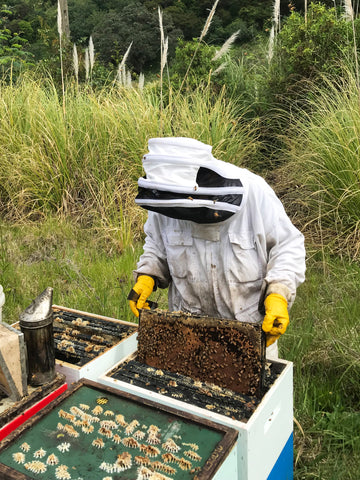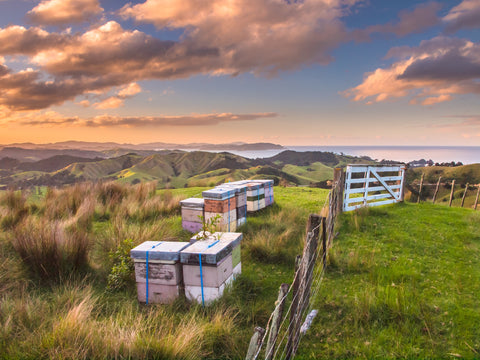1. The Basics
2. What Is MGO: Manuka Vs Regular Honey
3. Uses Of Manuka:
3a: Burn & Wound Treatment
3b: Acne & Other Skin Concerns
3c: Oral Health
3d: Sore Throat
3e: Digestive Health
3f: Influenza Vs Manuka
3g: Allergy Symptoms Vs Honey
3h: Manuka For Pets
4. Monofloral Vs Multifloral Manuka Honey
5. Australian Vs New Zealand Manuka Honey
6. What To Look For When Purchasing To Ensure You Are Getting Real Manuka Honey
7.Different Manuka Labels And What They Mean (MGO, UMF, K-Factor)
8. How To Read The Test Results (+ The Other Key Compounds In Manuka)
9. How To Choose The Right Strength For Your Needs And Recommended Dosage
10. Other Ways To Incorporate Manuka + Our Top 10 Food & Beauty Recipes To Get Your Creative Juices Flowing!
Want us to cover a topic you don’t see here? Reach out on Instagram, Facebook or Telegram or go old school and give us a ring, Monday through Friday at (805) 684-0624
________________________________________________________________________________________________________________________
1. The Basics
Manuka Honey is made in New Zealand & Australia by bees who pollinate the Manuka tree and contains MGO, short for methylglyoxal, a compound not found in other types of honey. This compound gives Manuka honey unique health benefits.
Return to top ↑
2. What is MGO: Manuka vs Regular Honey
There are many different types of honey, each with its own unique characteristics but the most common question we get is: how is Manuka honey different from regular honey?
To answer that, we first need to determine what “regular” honey is! Let’s say it can fall into two categories:
1- Multifloral, processed & pasteurized honey, often mixed with other sweeteners
2- Raw honey, from multi or monofloral sources excluding Manuka
Assuming we can agree that any raw honey is far superior to the first category, let’s dive into the differences between manuka honey and other raw honey types.
The biggest difference, of course, is the MGO! Yup, you’ll hear that abbreviation a whole lot around here & find it prominently displayed on the front of our jars. That’s because MGO stands for methylglyoxal and it is what gives manuka its magic. Not found in any other honey, MGO has a range of anti-inflammatory and antibacterial benefits.
Now you might say that regular raw honey also has these benefits and, technically, you would be correct. However, with these honey types, the benefits come from peroxide activity. This activity doesn’t do much for the human body. Since too much peroxide is bad for us, we have an enzyme called Catalyse which quickly breaks peroxide down into water and oxygen making its effects very short-lived.
Your body's defenses do not attack MGO, so you can take full advantage of its benefits inside and out!
Return to top ↑
3. Uses of Manuka
There are so many benefits to manuka honey both when used externally and internally and we’ve listed some of our favorites below. As always, we’ve included study links, but also encourage you to do your own research! There are far more amazing uses and studies related to manuka honey than we could ever cover here.
3a: Burn & Wound Treatment - Historically, honey has been recognized around the world for its antibacterial and anti-inflammatory properties that can help promote healing, tissue regeneration, and reduce pain. It has even been found effective against many antibiotic-resistant strains of bacteria. Combined with its humectant effect, this makes manuka honey uniquely superior to many traditional treatments. Read more here.
3b: Acne and other skin concerns - More & more studies are finding what traditional medicine knew all along: That honey is efficacious in treating a range of skin disorders from acne to eczema & psoriasis. You can add manuka honey to your daily skincare routine to improve your skin’s appearance by fighting bad bacteria and inflammation, and keeping your skin healthy, moisturized, and nourished.
3c: Oral Health : Manuka Honey will help reduce plaque by preventing the development of biofilms, which make plaque harder to remove. It also restricts bacteria formation preventing tooth cavities and other gum problems like periodontal disease, gingivitis, bleeding, receding gums, dry mouth, and bad breath.
3d: Sore Throat: Recent studies have shown that manuka is more effective than OTC products against sore throat & cough due to its unique anti-bacterial, antimicrobial and anti-inflammatory properties. It has been shown to inhibit the development of strep throat and even stimulate immune cells!
3e: Digestive Health: Manuka has been found to act as a prebiotic by stimulating the growth of good bacteria, while at the same time its antibacterial effects actively fight against disease-causing bacteria. It has shown promise in treating a range of digestive issues from IBS and ulcerative colitis to C. diff.
3f: Influenza vs Manuka: A recent study showed that manuka honey may be just as, if not more effective, against the flu than the popular OTC drugs. Tested against a common flu strain and also against other types of honey, manuka showed the highest potency and ability to actually inhibit the growth of the virus. Additionally, it has been found more effective than traditional treatments such as antibiotics in treating symptoms of Upper Respiratory Tract Infections (URTIs)
3g: Allergy Symptoms: Despite what you may have heard, studies show that honey cannot cure your allergies. Even local honey and yes, even our honey! That said, the unique antibacterial & anti-inflammatory properties of manuka honey are shown effective against a range of allergy symptoms and related diseases making it a great natural allergy relief alternative to OTC options. Read more here.
3h: Manuka for Pets: Many pets can appreciate the same benefits from Manuka honey that we do. It's used widely to treat burns, wounds, hot spots & other skin issues on all sorts of animals, especially dogs, cats and horses. Dogs can also take advantage of its benefits internally for oral health, as a prebiotic, for added immune protection & much more. Read more about its uses, as well as how much to give your pet based on their size, here.
Return to top ↑
4. Mono vs Multi-Floral Manuka Honey
While most monofloral honey (i.e. clover, orange blossom, etc.) is pollen tested to prove its’ source, Manuka honey regulations are even more involved.
In order for Manuka honey to be certified as Monofloral, the nectar must be predominantly Manuka and when tested the honey must contain a higher level of two of the four naturally occurring markers. Monofloral Manukas tend to come in higher strengths as the concentration of Manuka is higher.
Multifloral Manuka is created when honeybees forage from the Manuka flower and other floral sources. To be classified as Multiflora Manuka, the honey must contain mainly Mānuka nectar and meet four naturally occurring markers. Here is an example markers test.
What does this mean for you? If you wish to obtain the optimal benefits that Manuka offers, Monofloral is your ticket. However, if you’re looking for smooth, tasty honey that still has more naturally occurring benefits and is cost competitive vs other raw honey, Multifloral is for you!
Return to top ↑
5. Australian vs New Zealand Manuka Honey
Manuka was discovered in New Zealand and thought to occur only there until much more recently. We now know Australia is host to over 80 species of Leptospermum, including the exact same plant - Leptospermum Scoparium - as is found in NZ.
Due to the larger variety of manuka species, Australian manuka honey has a different flavor and color profile & is less likely to crystalize. There is also less government oversight, a larger territory, and a longer Manuka flowering season, all factors which contribute to its lower price point.
The key factor is that both our Australian & New Zealand manuka lines are independently tested for and contain the active ingredient, MGO (methylglyoxal), giving Manuka its unique potency. You can see test results for both lines via the QR code on the jar lids.
Return to top ↑
6. What to look for when purchasing to ensure you are getting real Manuka honey.
By now you know that no matter what the label says (UMF, K-Factor, NPA) what you need to look for is the MGO concentration. If you cannot find the MGO amount…well, buyer beware!
On our New Zealand Manuka Honey Labels, we are required by the NZ MPI to include the following statement: “The 100% raw Manuka Honey in this jar was independently tested to ensure it has an MGO content of over 200+ mg/kg. This honey is compliant with Manuka Honey standards set by the NZ Ministry for Primary Industries. Product of New Zealand.”
While this is not currently required for manuka honey exported from Australia, we still put it through the same independent testing that our New Zealand line must go through, and, just like with our NZ line, you can access those test results via the QR code on the jar’s lid. Being able to access test results is important to ensure you are purchasing genuine manuka honey.
It is also prudent to look for where the honey was jarred. For instance, our jars read: “Sourced, packed and independently tested in New Zealand exclusively for and distributed by: PRI…”
Some brands export manuka from NZ in bulk containers and then mix it with other honey before jarring since there are no regulations for manuka in other countries, while others jar in NZ but hide their MGO content in order to sell you low-strength manuka at a higher price. This is why it’s important to look for both the MGO content and where the honey is jarred.
As the original importers of manuka to the U.S., we brought in manuka before they even knew what MGO was!! Having been there are all stages of knowledge about this amazing natural product, we have always strived to provide the most transparency possible. If you’d like to learn more about this & why our new labels are so important, click here.
Return to top ↑
7. Different Manuka labeling and what they mean (MGO, UMF, K-Factor)
With so many different manuka labels, it can be hard to figure out which manuka honey to purchase & which brand you can trust. What do all of those abbreviations even mean?
Let’s start by looking at what the New Zealand Ministry for Primary Industries says:
“Honey labeled as mānuka for export must be tested by an MPI-recognised laboratory to make sure it meets the new mānuka honey definition.”
The mānuka honey definition is made up of a combination of 5 attributes (4 chemicals from nectar and 1 DNA marker from mānuka pollen).”
Now that we know what is required for manuka honey to leave the shores of NZ, let’s look at some different terms you see on various manuka honey labels and what they really mean:
#1 - MGO. Short for methylglyoxal, MGO is the key medicinal component in manuka honey. Per MPI requirements all genuine manuka labeling should be based on this marker and indicated on the label. We put our MGO number right up front, so you don’t have to search for it.
#2 - UMF. Short for “Unique Manuka Factor”. UMF is a grading system, based on the NPA level of the honey & developed by a privately funded club: The UMF Honey Association. They will grant a license to a company's product if it is tested and found to meet the specific UMF standards & give permission to use their logo on the label. This logo does add more cost to the end product and according to the new rules laid out by MPI, UMF can only be used as a purity grade, not an activity grade so you still need to look for the MGO number on the jar.
#3 - K-Factor. This labeling does not indicate the medicinal quality and/or activity of manuka honey. The company that uses this labeling states that their definition of k-Factor is built around 5 key factors: “Traceability from hive to home, raw & unpasteurized, non-GMO verified, produced & packed in NZ, and free of antibiotics, glyphosate, and pesticides.” None of these tell you anything about the activity (MGO) content and antibacterial ability of the product, nor will you find the MGO level anywhere on their jars.
Return to top ↑
8. Beyond MGO - the other key compounds in manuka. Plus, how to read your test results:
MGO may be the hero with the most star power, but it couldn’t even exist without these other key compounds, along with four markers the NZ MPI looks for and are required for the export license:
- DHA (Dihydroxyacetone) - This gives Manuka Honey its antibacterial properties, the higher the concentration, the stronger the antibiotic effect. MG is derived from the compound DHA.
- NPA: short for “non-peroxide activity”, this is the original term to describe Manuka’s unique activity and is the same as UMF.
- HMF: This is a marker used to ensure the honey is properly stored and has not been heated in any way.
But don’t worry - when you are reading your test results you don’t have to keep track of all of them! You really just need to look at the MGO and DHA numbers. For full instructions and an example test result, click here or learn via video.
Return to top ↑
9. How to choose the right strength for your needs.
Let us help you save some money honey…or, honey money? Not sure, but either way, we’re all tightening our spending right now and the reality is…you don’t need the highest strength to get the benefits.
In fact, your body can only use so much at a time anyway! Here is a chart to help you choose the right one for your needs & lifestyle: What is a good strength for Manuka Honey? See the uses and Manuka Honey ratings table below.
Return to top ↑
10. Other ways to incorporate manuka + our top 10 recipes to get your creative juices flowing 😋
Drink it, dip it, blend it, bake it, take it - incorporating manuka into your daily routine couldn’t be easier!
Whether you simply add a tablespoon a day as part of your wellness routine, incorporate it into your favorite foods, make your own skincare recipes or add it to your beverages the possibilities really are endless. Here are our top 5 edible recipes and our top 5 body care recipes to get your creative juices flowing: #1 - Strawberry Honey Lime Mimosas: why not add benefits to your bubbles? #2 - Homemade Apple Cider Vinegar Using Scraps: upgrade your ACV shots with the power of MGO! #3 - Sweet Potato Mocha Ice Cream: we cracked the code and made a nutritious ice cream that doesn’t make us miss our Ben & Jerry’s. #4 - Lemon Twist Dessert Hummus: already a delicious & nutritious dessert, we made it even better with our Lemon Twist Manuka Honey. #5 - Honey Boba Tea: tastes just like the boba you love only this one is dairy & refined sugar-free. BODY CARE #1- Manuka Honey & Propolis Salve by GrowForageCookFerment: toss your Neosporin, this simple salve has all the same pros, with none of the cons. #2 - Manuka & ACV Cuticle Treatment: protecting your cuticles is key to having healthy nails. This treatment also protects against fungus and has only 4 ingredients! #3 - Manuka Exfoliator: the single ingredient method to gently exfoliate. Technically not a recipe but absolutely necessary information! #4 - Moisturizing Bath Soak: This one is so easy, we’ll just drop it here. Dissolve two tablespoons of manuka into a cup of warm water, add to the bath, and enjoy. #5 - Manuka Honey Facial Spray: spray the dry skin away with green tea & nature’s best humectant - Manuka honey! Return to top ↑













